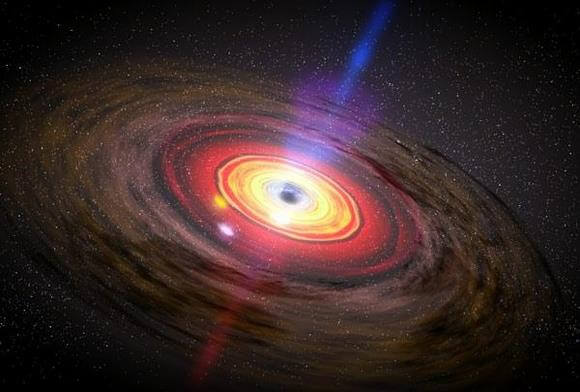A new type of cosmic flash may reveal the birth of a black hole for the first time: when a massive star runs out of fuel, it collapses in on itself under its own gravity and, if it's big enough, becomes a black hole

A new type of cosmic flash may for the first time reveal the birth of a black hole: when a massive star runs out of fuel, it collapses in on itself under its own gravity and if it's big enough it becomes a black hole, an object so dense that even light cannot escape its grip. According to a new analysis by a physicist from the California Institute of Technology (Caltech), shortly before the newly discovered black hole was formed, the dying star produced a huge burst of light that could allow astronomers to witness the birth of the black hole for the first time.
Some of the dying stars are turned into a black hole by a large eruption during which gamma ray bursts occur, which are one of the most energetic phenomena in the universe. However, these cases are rare, and require exotic circumstances, explains Piro. "We don't think most black holes form this way." In most cases, according to a certain theory, a dying star forms a black hole without explosions and flashes: the star will simply appear as if it has disappeared from the sky. "You don't see the explosion", says Piro, "you see it disappear".
According to Pirro, this is not the case. "Maybe they are not as boring as it seems to us", he says. According to a well-established theory, when a massive star dies, its core collapses under its enormous weight. As it collapses, the protons and electrons that make up the nucleus fuse and produce neutrons. For a few seconds before it completely collapses and becomes a black hole, the core becomes a dense and highly compressed object known as a neutron star. In order to illustrate the high density, it is possible to imagine that all the mass of our sun would be compressed into a sphere with a radius of only 10 kilometers (!).
This collapsing process also creates neutrinos, particles that pass through almost any material at speeds close to the speed of light. When the neutrino flux flows out of the core, the particles store within them extremely high energy.
According to an article published in 1980 by scientist Dmitri Nedzin from the Alikhanov Institute of Theoretical and Experimental Physics in Russia, this rapid loss of mass means that the gravitational strength of the dying star's core will suddenly decrease. When this happens, the outer gas layers made mostly of hydrogen that still surround the core will fly outwards creating shock waves that will fly through the outer layers at a speed of 1,000 kilometers per second.
Two astronomers from the Santa Cruz Institute recently found that when the shock waves hit the outer layer, it will heat the gas on the surface and produce light that will shine for about a year - a sign that may help scientists understand that this is indeed the formation of a black hole. Although the light will shine a million times brighter than our Sun, the light will be relatively dim compared to other stars. "It will be difficult to detect the light, even in galaxies that are relatively close to us," says Piro.
But now according to him, the sign is found. In the new study he published, he predicts that there should be a flash of light 10 or 100 times greater than what previous studies predicted. "This flash is going to be very bright, and it gives us the best opportunity to watch an event take place."

11 תגובות
When you take a piece of meat and dip it in liquid cheese also called "milk" and you give it to a Jew, will he agree to eat it? I'm afraid not because it's not kosher, so take this example and see how the black hole actually formed
For the first time physicists *can* witness the birth of a black hole. The title is not accurate
Oish, stop confusing nonsense as if you know something... a bunch of ignorant fools!!!
Shimmy
It has nothing to do with the Achilles and the tortoise paradox. This paradox speaks of movement under completely normal conditions.
point
It is not true that time stops at the edge of a black hole. Time slows down but does not stop - after all, gravity there is not infinite.
And it certainly has nothing to do with an outside observer. Time with him continues as usual.
hi point This is the tortoise and the hare paradox. In the end, the black hole was predicted.
Nir, how do you know that? After all, just before the black hole is formed, time there slows down infinitely. So from the point of view of the outside observer the whole mass seems to be slowing down more and more on the event horizon to the point of stagnation. And then actually the black hole didn't form. Only after infinite time will it be created.
The mass of a star collapses finitely, therefore the duration of black hole formation also finitely
Me too 🙂
NN - I love you!!!
It seems to me that blacks do not exist. They take an infinite amount of time to form from the perspective of outside observers. Just like a suicidal astronaut falling into a black hole, it will appear from the outside as if it takes an infinite amount of time to reach the event horizon. Likewise, a black hole does not form in finite time.
Black holes only exist at the edge of the universe.